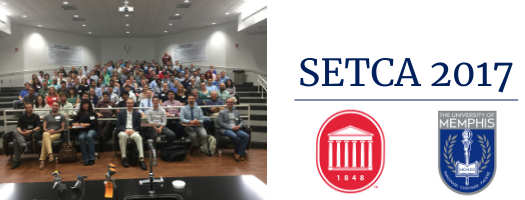Location
Coulter Hall, Room 211
Start Date
19-5-2017 9:00 AM
Description
The development of new catalysts for asymmetric organic reactions typically proceeds by the experimental screening of potential new designs. This requires the synthesis and testing of many catalysts that will ultimately prove ineffective. We envision an alternative approach to catalyst development driven by the computational screening of virtual libraries of potential designs. Toward this end, I will describe a Perl module (AaronTools) that provides functions for building, manipulating, and analyzing molecular and supramolecular structures, creating input files and parsing output files from popular electronic structure packages, and interacting with common batch queuing systems. I will also introduce a computational toolkit built using these tools (AARON: An Automated Reaction Optimizer for New catalysts) that automates the optimization of the 100s of transition state and intermediate structures needed to predict stereoselectivities of complex asymmetric organic reactions.[1-2] Illustrative examples of the application of AARON will be presented,[3] along with a brief summary of the latest developments.[4]
Relational Format
Conference proceeding
Recommended Citation
Wheeler, Steven E., "IL2. Tools for the Computational Design of Asymmetric Catalysts" (2017). Southeast Theoretical Chemistry Association Meeting (SETCA). 5.
https://egrove.olemiss.edu/setca/2017/schedule/5
IL2. Tools for the Computational Design of Asymmetric Catalysts
Coulter Hall, Room 211
The development of new catalysts for asymmetric organic reactions typically proceeds by the experimental screening of potential new designs. This requires the synthesis and testing of many catalysts that will ultimately prove ineffective. We envision an alternative approach to catalyst development driven by the computational screening of virtual libraries of potential designs. Toward this end, I will describe a Perl module (AaronTools) that provides functions for building, manipulating, and analyzing molecular and supramolecular structures, creating input files and parsing output files from popular electronic structure packages, and interacting with common batch queuing systems. I will also introduce a computational toolkit built using these tools (AARON: An Automated Reaction Optimizer for New catalysts) that automates the optimization of the 100s of transition state and intermediate structures needed to predict stereoselectivities of complex asymmetric organic reactions.[1-2] Illustrative examples of the application of AARON will be presented,[3] along with a brief summary of the latest developments.[4]



Comments
Download includes an expanded abstract with collaborators, institutional affiliations and cited references.